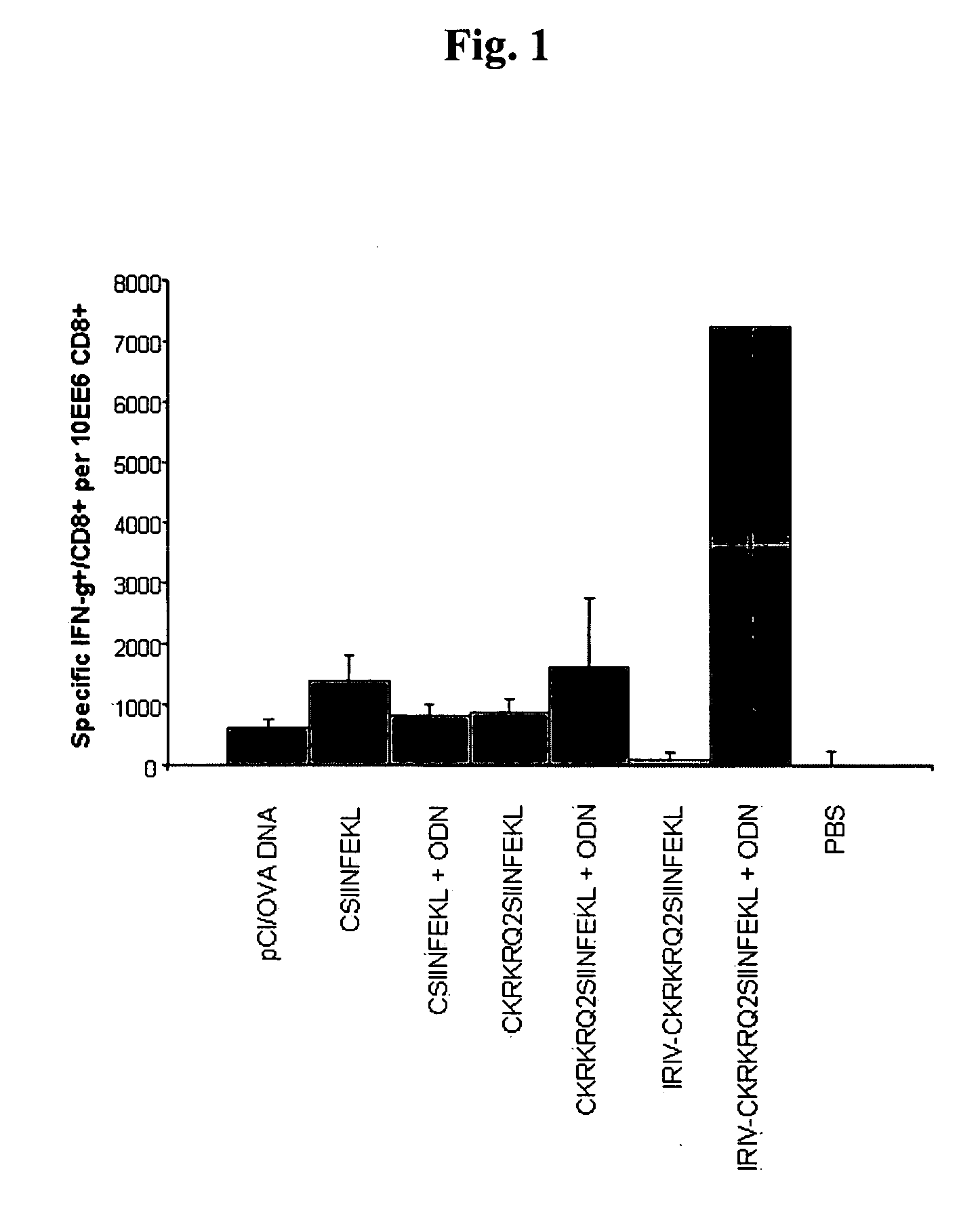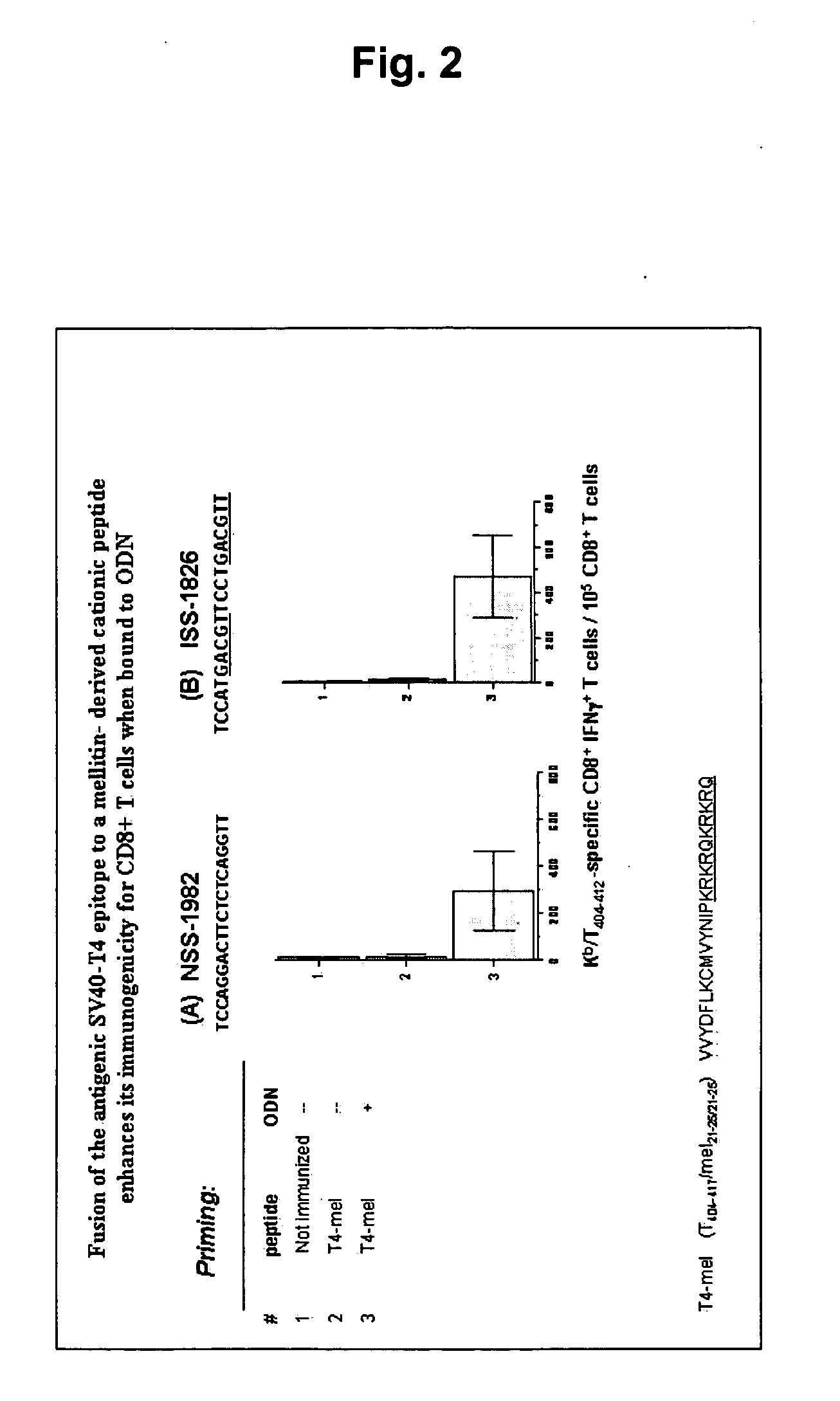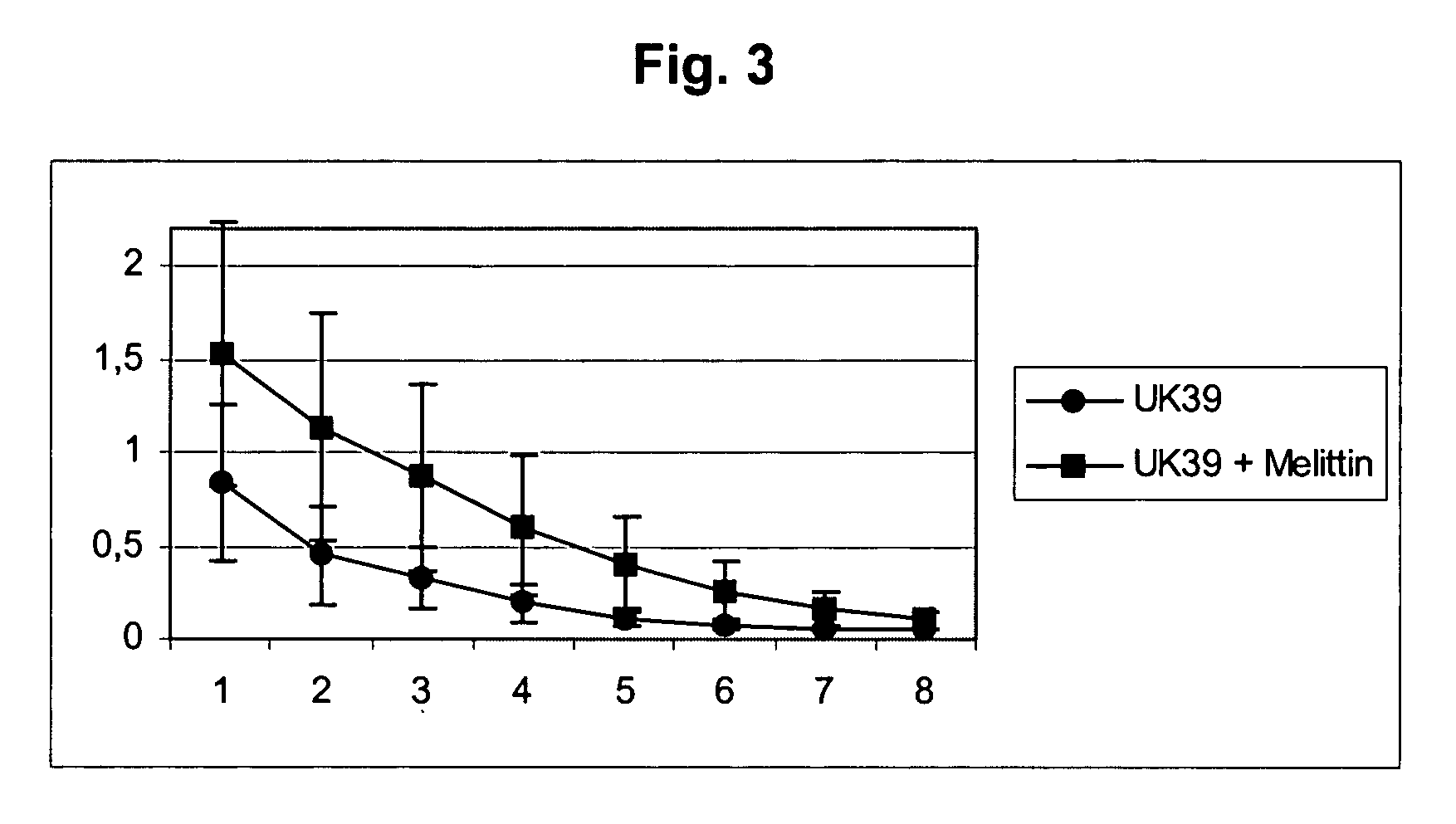Compositions and methods for the potentiation of immune responses against target antigens
a technology of immune response and target antigen, which is applied in the field of compositions and methods for the potentiation of immune response against target antigens, can solve the problems of limiting the usefulness of clinical applications, the optimal delivery form of odn as adjuvant has not been elucidated, and the generation of sufficiently potent immune responses, so as to enhance or potentiate immune effector cell activation, increase the immune stimulatory effect of compositions, and enhance or poten
- Summary
- Abstract
- Description
- Claims
- Application Information
AI Technical Summary
Benefits of technology
Problems solved by technology
Method used
Image
Examples
example 1
[0075] This example shows that a melittin-derived peptide (mel, KRKRQKRKRQ, SEQ ID NO: 2) is not dependent on the presence of CpG sequences in the ODN to show its full adjuvant activity. Fusion of a sample antigen (here, T4 peptide) to the melittin-derived peptide and binding ODN to them creates potent immunogens for CD8+ T cells. A sample target antigen, the SV40-derived T4 peptide T404-417 VVYDFLKCMVYNIP (SEQ ID NO: 5) was fused to a duplicated amino acid sequence derived from melittin (KRKRQKRKRQ, SEQ ID NO: 2). B6 mice were vaccinated i.m. with 35 nmol of these peptides alone (group 2), or mixed with ODN (group 3), not containing (A; NSS+ ODN-1982), or containing (B; ISS+ ODN-1826) CpG motifs (FIG. 1). Spleen cells obtained from immune mice 12 days post-vaccination were restimulated ex vivo with the T4 peptide VVYDFLKCM (SEQ ID NO: 4) (Kb / T404-412). Mean numbers of specific IFNγ+ CD8+ T cells / 105 CD8+ T cells±SD (of 6 mice per group) averaged from two independent experiments are...
example 2
[0077] This example shows how the immune-stimulatory compositions of the present invention, including melittin-derived peptides and target antigens, can be coupled to the surface of virosomes. Chemicals: Octaethyleneglycol-mono-(n-dodecyl)ether (OEG, C12E8) was from Fluka. Egg phosphatidyl choline (PC) was obtained from Lipoid (Cham, Switzerland). Phosphatidylethanolamine (PE) was obtained from R. Berchtold (Biochemical Laboratory, University of Bern, Switzerland). N-γ-maleimidobutyryloxysuccinimide ester (GMBS) was purchased from Pierce (cat. no. 22309). Peptides were purchased from Bachem (Bubendorf, Switzerland). Bio-beads SM2 and Bio-Gel A-15m were from Bio-Rad Laboratories (Glattbrugg, Switzerland).
[0078] Peptide bearing influenza virosomes (IRIVs) were prepared by first crosslinking the Cys-terminus of the peptide to PE via GMBS. Briefly, 10 mg PE was resuspended in 200 μl chloroform / methanol 9:1 and 5 μl triethylamine (99%) before 1.7 mg GMBS was added. The mixture was incub...
example 3
[0079] This example shows the preparation of IRIV with encapsulated molecules: IRIV were basically prepared as described by Zurbriggen et al. (Zurbriggen et al., Prog. Lipid Res. 39:3-18, 2000). Briefly, 32 mg egg PC and 8 mg PE were dissolved in 2 ml of PBS containing 100 mM OEG (PBS / OEG). Influenza A / Singapore was purified as described (Skehel and Schild, Virology 44:396-408, 1971). Influenza virus corresponding to 4 mg hemagluttinin (HA) was centrifuged at 100,000×g for 1 hour and the pellet was dissolved in 1 ml of PBS / OEG. To prepare antigen and / or melittin-IRIV, 4 mg of peptide was dissolved in 1 ml PBS / OEG. The phospholipids, the dissolved virus solution and the peptide and ODN solutions were mixed and sonicated for 1 min. This mixture was centrifuged at 100,000×g for 1 h and the supernatant sterile filtered (0.22 μm). Virosomes were then formed by detergent removal using 1.23 g of wet SM2 Bio-Beads for 1 h at room temperature with shaking and three times for 30 min with 0.6 ...
PUM
| Property | Measurement | Unit |
|---|---|---|
| concentration | aaaaa | aaaaa |
| volume | aaaaa | aaaaa |
| total volume | aaaaa | aaaaa |
Abstract
Description
Claims
Application Information
 Login to View More
Login to View More - R&D
- Intellectual Property
- Life Sciences
- Materials
- Tech Scout
- Unparalleled Data Quality
- Higher Quality Content
- 60% Fewer Hallucinations
Browse by: Latest US Patents, China's latest patents, Technical Efficacy Thesaurus, Application Domain, Technology Topic, Popular Technical Reports.
© 2025 PatSnap. All rights reserved.Legal|Privacy policy|Modern Slavery Act Transparency Statement|Sitemap|About US| Contact US: help@patsnap.com



